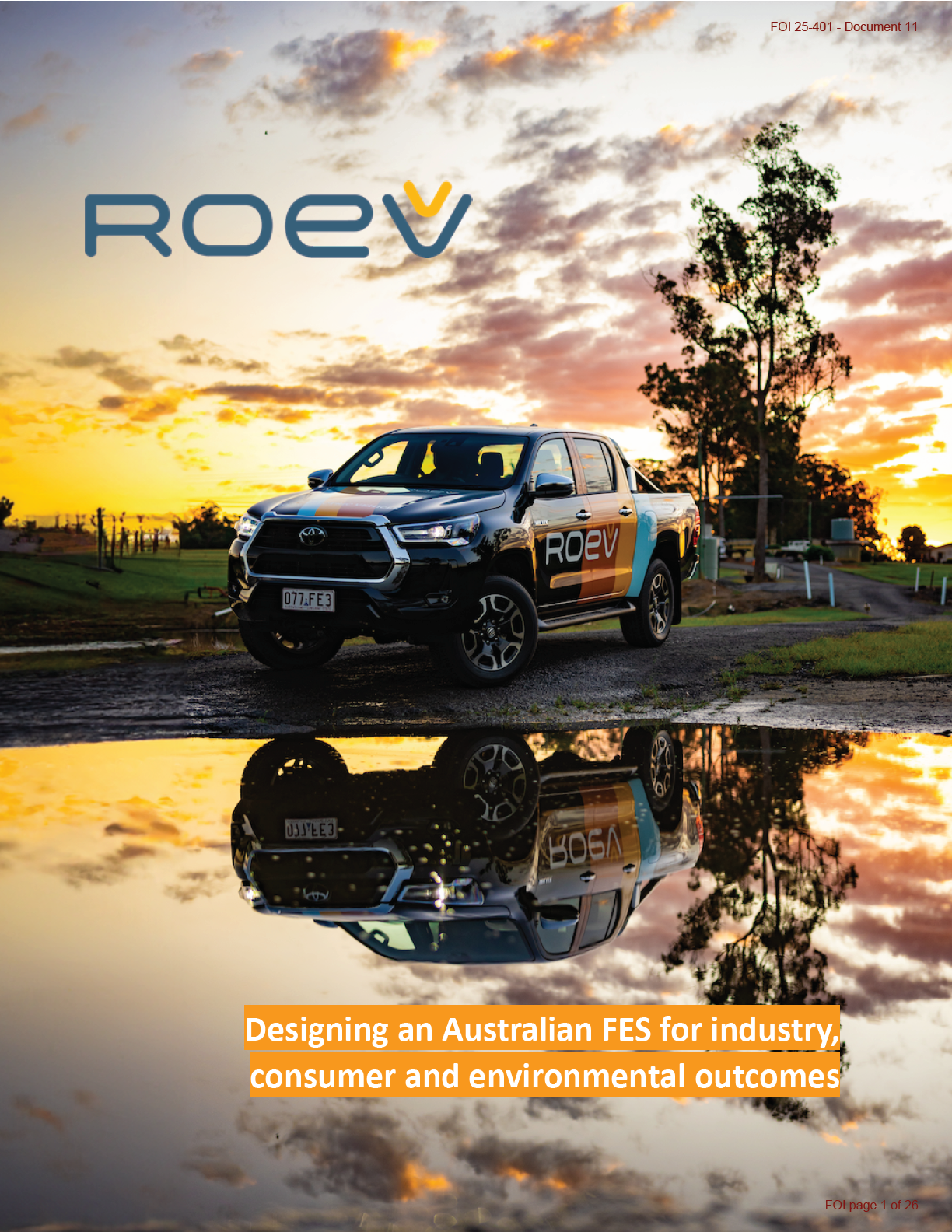
Arts
the
and
Infrastructure,
of Sport
Department
the
by Communications,
1982
Act
FOI Development,
the
under Regional
Released Transport,
FOI 25-401 - Document 11
Designing an Australian FES for industry, consumer and
environmental outcomes
Information Briefing: May 2023
Arts
Emissions outcomes, choice and industry growth through thoughtful, efficient FES
the
● Commercial vehicle and Passenger vehicle segments as defined in the ADRs should have
unique targets reflecting the unique demands Australians have on their vehicles
and
●
Appendix A includes detailed optimal targets. To accelerate EV supply and attract local
investment in Australian made EVs, the initial fuel efficiency target should be:
Infrastructure,
○ Set at 109.3g/km CO2 (4.7L/100km Petrol) for Passenger Vehicles (2024)
of
○
Sport
Set at 153.4g/100km (6.6L/100km Petrol) for Light Commercial Vehicles (2024)
○ Reduce by at least 4.75% per year until meeting and tracking EU targets
● EV Super Credits tuned to favour local production of vehicles will deliver outsized EV
supply outcomes by accelerating permanent local supply capacity and effects of scale
●
Appendix B shows annual emissions reduction through FES inclusion of a policy of ‘5
Super Credits for minimum local content EV’ doubles the rate of emissions reduction of
adopting strict fleetwide emissions targets
Department
● Optimal outcomes are achieved through a sliding-scale of Super-Credits according to local
content and jobs impact, optimised to attract investment and local EV production
the
○ Whole new EVs assembled in Australia using Australian manufactured battery cells
Communications,
receive 10 EV Super Credits per 1 EV sold
by
○ Whole new EVs assembled in Australia using battery packs assembled in Australia
receive 5 EV Super Credits per 1 EV sold
○ EV conversions assembled in Australia using packs assembled in Australia should
1982
receive 5 EV Super Credits per 1 EV converted
○ Electric vehicle conversions assembled in Australia using packs assembled elsewhere
Act
should receive 2 EV Super Credits per 1 EV converted
● Qualification for ‘local content’ Super Credits should require at least the installation of
FOI Development,
energy-store (battery) and propulsion system (e-motors) in Australia
● Roev has applied industry data and developed a helpful tool to design FES scheme
the
parameters that optimise short-and-long-term supply of EVs, avoid vehicle ownership cost
increases, minimise industry push-back, and that drives uplift in local jobs and investment
● Hybrid and Plug-in Hybrid technology does not have commercial barriers and so any Super
Regional
Credit scheme should avoid Super Credits for the supply of this vehicle technology
under
● The Roev FES design proposal (Appendix A) will deliver over and above existing proposals:
○ Avoidance of vehicle ownership cost increases in early years
○ Competitive EV supply conditions vs competing markets accounting for real markets
○ Increased OEM investment in clean vehicle technologies and electrification
○ Accelerated supply from new EV manufacturers and brands
Released Transport,
○ Accelerated near-term local supply of EVs and associated economic benefits
○ More attractive new EV pricing and more zero emission vehicle options
CONFIDENTIAL - NOT FOR PUBLIC DISTRIBUTION
FOI page 2 of 26
FOI 25-401 - Document 11
Section by Section Feedback
Assumptions:
Consultation paper
Arts
Apply only to vehicles entering the Australian market for the first time. The Australian FES will
only apply to new vehicles, whether imported or manufactured domestically. It will not apply to
vehicles in the domestic used car market.
the
Recommended changes
and
● “
Apply only to vehicles entering the Australian market for the first time” unnecessarily
precludes the mass-electrification of new and near-new vehicles from organisations such
Infrastructure,
as Roev, SEA Electric, GB Auto, Tembo and Mevco. Where OEMs have failed to invest in
of Sport
global-scale platform electrification, efficient and effective Australian companies have
stepped into the void. The FES should avoid design assumptions that preclude emerging
segments of the market from participation
○ Example remedied framing - “
Apply only to vehicles with VINs registered as
electric vehicles in the Australian market for the first time. The Australian FES will
apply whether vehicles are imported, converted domestically or manufactured
domestically. It will not apply to vehicles on-sold in the domestic used car
Department
market.”
○ Such a framing can be validated or audited through periodic NEVDIS reporting in
the
the same way ‘plate fees’ are determined periodically for light touch
by Communications,
administration.
Consultation paper
Apply on average to vehicles sold. The Australian FES will protect the continued sale of vehicles
1982
Australians love, including utes and 4-wheel drives and will work to lower average emissions
over time. A FES will provide good incentives for suppliers to provide more efficient internal
Act
combustion engine technology, including hybrids, and bring popular and more affordable LZEVs
to Australia to
FOI Development,
Recommended changes
the
● “
Apply across the entire vehicle fleet for each vehicle supplier. The Australian FES will be
designed to protect the continued availability of the types of vehicles already in the
market. The overall incentive of the FES will be to bring forward clean vehicle
Regional
technologies into the market, rewarding vehicle users with lower fuel bills and a greater
under
choice of clean vehicle technologies.
● As written in the FES Consultation Paper, the statement implies that the light commercial
vehicle segment and broader 4x4 segments are unable to be readily transformed by
clean vehicle technologies. The current approach is a powerful and flawed policy false
premise that limits vision and outcomes without presenting a case for such implied
Released Transport,
assertions.
CONFIDENTIAL - NOT FOR PUBLIC DISTRIBUTION
FOI page 3 of 26
FOI 25-401 - Document 11
● The FES should recognise the patterns of legacy industry policy pressure in other
markets, noting the incredible scale of response possible once the dust of efficiency
standards settles.
● Most legacy large scale OEMs have families of ICE engines and hybrid systems in the
Australian market or other regions that can significantly improve fuel efficiency with no
Arts
effects on towing or range - two often-cited factors sensitive in regional Australia.
Transitional technologies such as alternator-replacing mild-hybrids and bell-housing
the
mounted hybrid and PHEV technologies are not overly challenging to integrate with
existing platforms. These require around 6 months of engineering and validation to bring
and
to market.
● Australian FES should recognise that while Australia is a relatively small and
Infrastructure,
right-hand-drive market, corporate decisions on clean vehicle technologies are not
of
commanded by larger markets, but rather a balance of risk and profitability decisions.
Sport
Australia’s moves on FES design from a system-balance view can have cascading effects
on technology timelines, despite the arguments put forward by local sales agencies
representing the most profitable policy standpoints for their international parent
organisations.
● Considering the LCV and Passenger Vehicle markets as requiring separate fuel efficiency
targets is rational, reflective of market forces, and enables FES pressure to be applied
Department
equitably and equally across vehicle segments. LCV segment vehicles for example
include minimal technologies enabling efficiency due to their legacy focus on emerging
the
markets, whereas vehicle manufacturers now have deep pools of efficiency technologies
Communications,
in their ‘parts bins’ enabling rapid, early efficiency gains.
by
● It is not appropriate to consider LCV and Passenger Vehicle markets as one due to
inequitable distribution of incentives across OEMs and reduced emissions impacts.
Instead, appropriate target setting by segment leaves no vehicle users behind in the
1982
growth of clean vehicle technologies in their preferred vehicle type.
Act
Consultation paper
For the purposes of this consultation, ‘light vehicles’ mean passenger (M category) or
FOI Development,
commercial (N category) vehicles under 3.5 tonnes gross vehicle mass. They include sedans,
wagons, Sports Utility Vehicles, utes, 4-wheel drives, vans, but does not include motorcycles (L
the
category vehicles). Consideration will be given to ensure a FES covers all appropriate vehicles
and does not create an incentive to adopt alternative classifications for the purpose of avoiding
being covered by a FES
under Regional
Feedback
● A vector of workarounds to be wary of is the capacity of FCAI members to override and
self-appoint vehicle models into sales segments.
● A reasonable protection against such practices for the FES would be:
○
Released Transport,
define applicable vehicle categories according to Type Approval
CONFIDENTIAL - NOT FOR PUBLIC DISTRIBUTION
FOI page 4 of 26
FOI 25-401 - Document 11
● Notable workarounds by major vehicle suppliers are not uncommon, such as the move
of the vehicle supplier of the Toyota Landcruiser 70 series to increase GVM over 3,500 kg
to avoid NA category safety improvements required by the Australian Design Rules.
● A reasonable protection against such practices for the FES would be:
○ Vehicle models supplied under a Type Approval into the Australian market in
Arts
2023 under one vehicle category, may be considered under the FES to continue
to be measured against the requirements of that category if in the future years of
the
the FES even if they receive a Type Approval for supply under another category.
and
Consultation paper
Consider vehicle affordability, lifetime cost and model availability. We want to learn from best
Infrastructure,
practice FESs in other major markets, and make sure that Australians can still get the cars they
of Sport
need.
Feedback
● Learning from FESs in other markets provides a starting place and concepts that have
market acceptance and are most simple to communicate
● Rather than being limited by Departmental focus, FES policy must seek to
Department
simultaneously achieve Australian outcomes of jobs, industry investment, defence force
capability and supply chain development for national sovereignty and security
the
● The FES applies a market-forces approach that has the potential scale of impact on
industry investment and local jobs equivalent to the National Reconstruction Fund
by Communications,
● The Net Zero Committee of Cabinet is the appropriate body to ensure outcomes that
support broader remit of government and Roev commends Minister King’s
establishment of the Net Zero team to drive this agenda
1982
Act
FOI Development,
the
under Regional
Released Transport,
CONFIDENTIAL - NOT FOR PUBLIC DISTRIBUTION
FOI page 5 of 26
FOI 25-401 - Document 11
Roev FES design question feedback
Are there any design assumptions that you think will put at risk the implementation of a good
FES for Australia?
Arts
● Mass-electrification of new and near-new vehicles from organisations such as Roev, SEA
the
Electric, Tembo and Mevco will deliver upwards of 100,000 EVs to the Australian markets
prior to the arrival of BEV options from legacy OEMs, according to their own statements
and
via the FCAI. Where OEMs have failed to invest in global-scale platform electrification,
efficient and effective Australian companies have stepped into the void. Organisations
Infrastructure,
such as those above which have gone through a full engineering validation process will
of
contribute as much as the combined emissions savings of the legacy high volume ICE
Sport
vehicle suppliers combined to 2030.
● If safe and professionally developed new and near-new EV conversions at-scale are
excluded from FES policy inclusion at the point of design assumptions, FES will deliver:
○ Significantly lower emissions outcomes to 2030 ~ 0.5x
○ Thousands of unrealised jobs, billions in economic turnover and tax lost
○ 10-20GWh per year equivalent of battery off-take potential from the burgeoning
Department
Australian critical minerals and battery industry
○ An ‘us and them’ FES delivering less options for consumers and businesses
the
○ A less competitive economy with reduced opportunities for improved total cost
Communications,
of ownership through zero emissions technology
by
● The FES should avoid design assumptions that preclude emerging segments of the
market from participation
● The following graph presents the relative improvement to net emissions outcomes
1982
(contribution of the FES-governed vehicle fleet per year) - showing in yellow the
expected contribution of the professional retrofit sector, as compared to the maximum
Act
capacity of industry to reduce emissions year-on-year.
FOI Development,
the
under Regional
Released Transport,
CONFIDENTIAL - NOT FOR PUBLIC DISTRIBUTION
FOI page 6 of 26
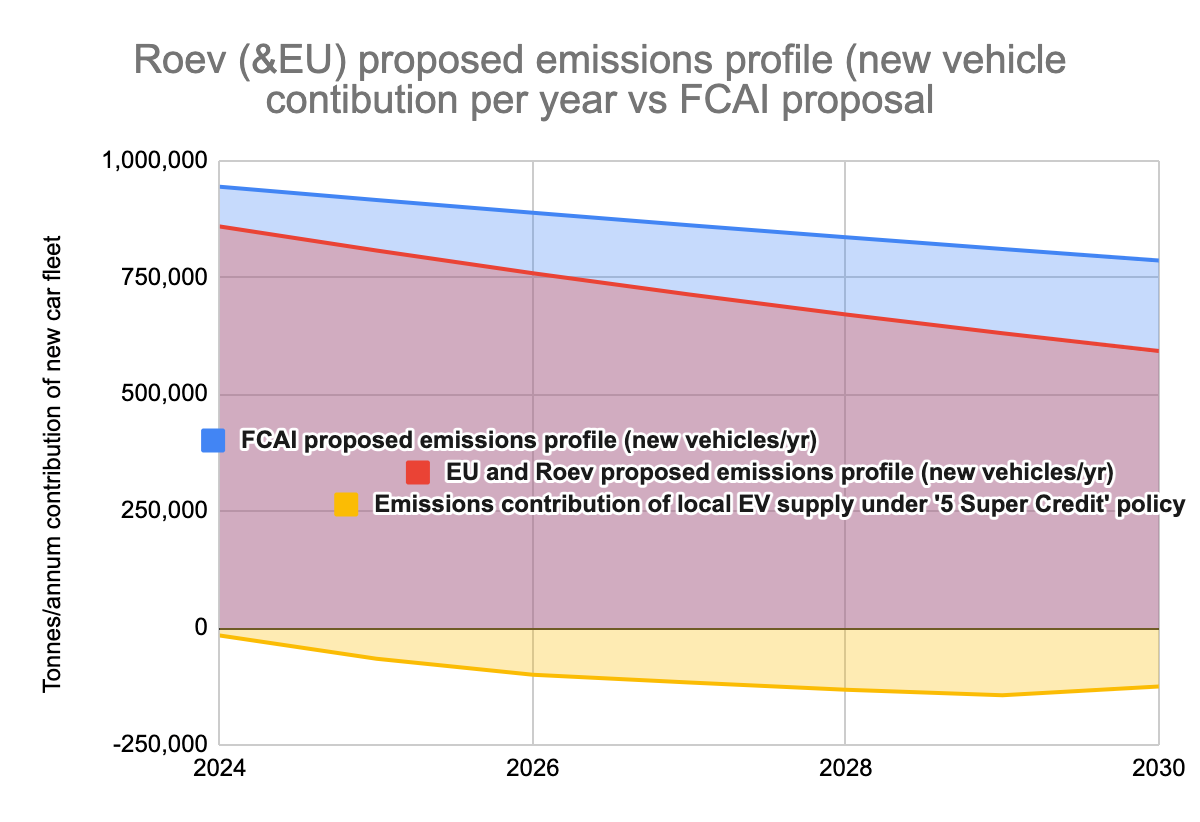
FOI 25-401 - Document 11
Arts
the
and
Infrastructure,
of Sport
Department
● Applying FES to
“vehicles with VINs registered as electric vehicles in the Australian
the
market for the first time” is the most appropriate framing, capturing the new and used
Communications,
vehicle conversions market, parallel imports market, and all type approval vehicle supply
by
pathways.
1982
What principles should we consider when setting a CO2 target, and how far ahead should
they be set? What should the FES average annual emissions ceiling (CO2 target) be?
Act
● A fuel efficiency target with associated trading of carbon credits is a cost-effective tool to
accelerate the local EV and battery industry where the dirtiest car makers either invest in
FOI Development,
clean vehicle technology or pay for their competitors to do so.
● The successful philosophy in EU/US was to set a
stretch fuel efficiency target and allow
the
OEMs to temporarily bridge to achieving the result through EV ‘Super Credits’. In Europe,
each EV sold into the market can be counted as ‘two’ vehicle sales to lower the average
emissions contribution per vehicle of an OEMs vehicle fleet.
Regional
●
under
To accelerate EV supply and attract local investment in Australian made EVs, the initial
fuel efficiency target should be:
○
Set at 109.3g/km CO2 (4.7L/100km Petrol) for Passenger Vehicles (2024)
○
Set at 153.4g/100km (6.6L/100km Petrol) for Light Commercial Vehicles (2024)
○
Reduce by at least 4.75% per year until meeting and tracking EU targets.
● These values are derived as a ‘stretch’ for established vehicle OEMs that is sufficient to
Released Transport,
incentivise their increased investment in capacity to supply. The figure is marginally
lower than the targets successfully achieved under the EU regulatory regime and is set
CONFIDENTIAL - NOT FOR PUBLIC DISTRIBUTION
FOI page 7 of 26
FOI 25-401 - Document 11
to ensure targets are achievable, responsible, and deliver total ownership cost benefits.
● ‘Super Credits’ reward vehicle suppliers for bringing zero emissions vehicles to market,
underwriting the risk for private investment in EV factories and supply chains by offering
a bonus ‘multiplier’ of the number of 0g/km vehicles accounted for in each sale.
● With Europe removing these temporary Super Credits from 2023, Australia can attract
Arts
EV volumes from 2023 by offering similar Super Credits to the European regime.
It is
anticipated through modelling that the net impact to fleetwide emissions abatement
the
can be doubled to 2030 through careful Super Credit design favouring local investment
and production. Allocating Super Credits to attract investments in locally manufactured
and
EVs serves to establish resilient local supply chains that thrive even as Super Credits are
abated.
Infrastructure,
●
Commercial vehicle and Passenger vehicle segments as defined in the ADRs should
of
have unique targets reflecting the unique demands Australians have on their vehicles.
Sport
● Roev believes there is an ideal start and end point to the ceiling for fuel efficiency over
time. Targets by year proposed below maximise the annual improvement in fuel
efficiency without driving cost of ownership increases - a difficult balance achieved
through development of a market model. The proposed commercial vehicle and
passenger vehicle segment fuel efficiency / emissions target that delivers:
○ Avoidance of overall ownership cost increases;
Department
○ Sufficient incentive and time for OEMs to respond with clean vehicle
technologies; and
the
○ Recognition of the uniqueness of the Australian vehicle market and our
Communications,
dependence on commercial vehicles
by
FES model & segment
2024
2025
2026
2027
2028
2029
2030
FCAI passenger
1982
134
128
122
116
110
104
98
FCAI commercial
177
172
166
160
154
149
143
Act
UN passenger
95
80.75
80.75
80.75
80.75
80.75
61.8
UN commercial
147
125
125
125
125
125
95.6
FOI Development,
Proposed passenger
109.3
103.8
98.6
93.7
89
84.5
61.8
Proposed commercial
153.4
145.8
138.5
131.5
125
125
95.6
the
● Roev recommends implementation of the reference masses put forward through
published FCAI FES system concepts. These are captured in the table below and
under Regional
accurately reflect the mass of vehicles that consumers in Australia buy, and reflect an
appropriate growth rate of mass for clean vehicle technologies and safety
advancements. Reflecting a different reference mass would negatively impact consumer
choice.
● Despite alignment to the FCAI published reference masses, Roev does not recommend
adoption of the mass-slope presented by the FCAI. The mass-slope the FCAI presents
Released Transport,
enables manufacturers to add content to vehicles to increase the vehicle mass to move
fuel efficiency targets in a way that exceeds the actual negative effect of mass on fuel
CONFIDENTIAL - NOT FOR PUBLIC DISTRIBUTION
FOI page 8 of 26
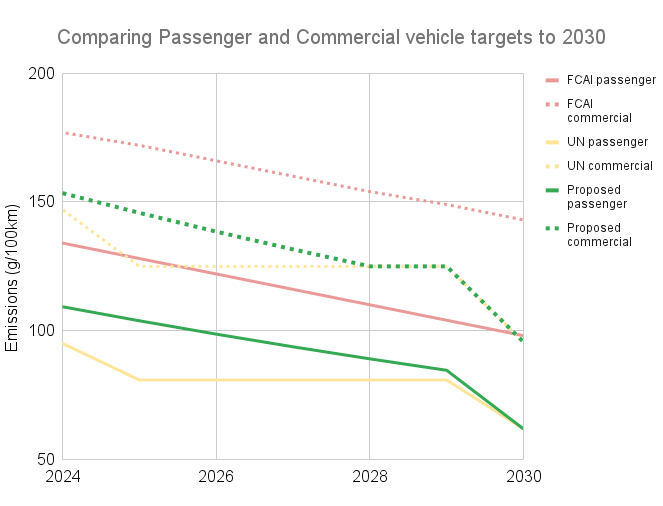
FOI 25-401 - Document 11
consumption. This is a negative incentive and a fuel economy avoidance strategy and
Roev recommends the adoption of the EU standard.
Attribute
2024
2025
2026
2027
2028
2029
2030
Arts
Recommended CO2 Target
109.3
103.8
98.6
93.7
88
84.5
61.8
Recommended Reference Mass
1578
1584
1589
1594
1599
1604
1609
the
Recommended efficiency-to-mass
0.033
0.033
0.033
0.033
0.033
0.033
0.033
slope (from EU system)
and
FCAI efficiency-to-mass Slope
0.07
0.068
0.065
0.063
0.061
0.058
0.056
Proportional difference
212%
206%
197%
191%
185%
176%
170%
Infrastructure,
recommended vs FCAI
efficiency-to-mass slope
of Sport
● It is noteworthy that the FCAI is proposing a negative effect of mass on vehicle efficiency
that is generally around twice the effect adopted and successfully operated under by
vehicle suppliers through EU policy. The following chart compares the proposed vehicle
targets to the FCAI proposed targets and EU market targets.
Department
the
by Communications,
1982
Act
FOI Development,
the
under Regional
Key points to observe:
Released Transport,
● Proposed Passenger and LCV targets track smoothly towards EU targets by 2028 without
setting technically unreachable targets, especially in the near-term years
CONFIDENTIAL - NOT FOR PUBLIC DISTRIBUTION
FOI page 9 of 26
FOI 25-401 - Document 11
● FCAI targets are set very high and do not trend towards targets of other markets
● FCAI targets reflect a ‘no solutions’ approach to LCV market emissions, with emissions
targets set unnecessarily high. This approach favours legacy OEM profit margin retention
over incentives to bring new or existing clean vehicle technologies to this market
Arts
Whether to incorporate flexibility mechanisms (credit exchange, banking or pooling
the
arrangements) to minimise impacts on consumers which are common features of other FESs.
● Credit exchange is a key attribute of a successful fuel efficiency standard. Complex tax
and
and government support structures, enterprise agreements, supply chain commitments
Infrastructure,
and design and development work complicates the path to clean vehicle technologies.
Some vehicle suppliers will be unwilling or unable to commit to the proposed fuel
of Sport
efficiency timelines and targets. Where these decisions overlap with highly purchased
vehicles or vehicle segments in the Australian market, credit exchange plays an
important role facilitating an orderly transition to clean vehicle technologies without
de-facto regulating free-choice away from businesses and consumers
● In other jurisdictions the markets with new fuel efficiency or emissions regulations
introduced were also the markets within which vehicle suppliers engaged in technical
Department
forums such as the European Commission and where they held local manufacturing and
engineering capacity. This enabled vehicle suppliers to pivot vehicle development in
the
advance. In the absence of this market condition, the Light Commercial Ute segment in
particular requires strong incentives to move the dial. In consideration of this point, the
by Communications,
extraordinary and unique profit margins of vehicle suppliers of ICE Utes should be
recognised as a powerful buffer from which to support cost effective clean vehicle
technologies.
1982
● Organisations such as Roev can develop electrification solutions for around 10% of the
development cost expended by legacy vehicle markers because we are focused on
Act
optimal drivetrain technology and vehicle safety integration. Our manufacturing
investments are also commensurate with 10% of the production volumes and hence we
are able to support the EV business case at lower volumes.
FOI Development,
● A credit exchange methodology can immediately bring competitive performant EV
options to businesses and consumers. Roev for example has been approached by ICE Ute
the
importers around collaborative technical arrangements. If designed appropriately
through stretch fuel efficiency targets and a credit exchange methodology, Roev and
others technology developers will be able to partner with high volume importers to
under Regional
enable electric options within 12 months. There are therefore pathways under a credit
exchange mechanism for large importers of Utes to supplement their ICE vehicle options
with EV options under new technical partnerships.
Released Transport,
CONFIDENTIAL - NOT FOR PUBLIC DISTRIBUTION
FOI page 10 of 26
FOI 25-401 - Document 11
Should bonus credits for new/innovative technologies be included in the FES, and how should
any potential risks be managed?
● Roev’s proposed FES target start point, reduction profile and end point were modelled
against the EU system and FCAI’s public policy proposal. Within these models of the
Arts
market, various Super Credit approaches were modelled under the market-norm 95 Euro
per gram CO2/km exceeded vs target across the fleet.
the
● The more strict targets of the EU are seen to drive significant fleetwide target ‘misses’ in
the near-term years and hence the value of EV Credits that dirty vehicle importers are
willing to pay is higher. These more strict targets drive excessive cost in the nearterm
and
years and these may not be recovered by vehicle users through lower running costs.
Infrastructure,
● Roev’s proposed targets produce a stunning system level outcome when coupled with a
sliding scale Super Credit system prioritising locally made or converted EVs. Strong
of Sport
incentives for investment into local EV production/conversion exist in this system design
- generating additionality through increased EV supply during a period where vehicle
importers have stated they do not intend to mass-produce EV solutions ‘from factory’.
● There is no relative disincentive to this system design where the fuel efficiency target is
designed with the effective number of system Super Credits in mind. Tougher early-year
targets maximise vehicle supplier clean technologies and increase the market for Super
Department
Credit purchase, while local content Super Credits enable a responsive EV supply.
● To minimise risks, Super Credits should not be made available to fully imported EVs.
●
the
Locally made conversions supplied to market as new vehicles would be certified to safety
standards established for new vehicles.
by Communications,
● Further risk minimisation for locally made conversions when applied to ‘used’ vehicles
should include the setting of a maximum build-date age for applicable conversion set at
2016.
1982
● Minimum safety requirements for converted vehicles to be eligible for Super Credits
should focus around active safety system ADRs and not introduce eligibility criteria that
Act
are more onerous than existing ADRs. This includes how they are applied to low volume
type approvals and should avoid testing that can not be validated effectively in Australia.
● ADR compliance benchmarks for eligibility should apply per the year of manufacture of
FOI Development,
the original vehicle, with reference to relevant ADR Applicability Tables.
● ADR compliance thresholds for conversions is a likely target of legacy vehicle supplier
the
influence campaigns. They should be designed collaboratively and transparently with
performance-based targets rather than prescriptive technology descriptors.
● Such a safety system for used vehicles would:
under Regional
○ Be certified by the states and territories as an ‘in-market’ certification, avoiding
administrative burden for the Department of Infrastructure.
○ Be certified according to administrative efficiency principles and administrative
leadership demonstrated by the Department of Infrastructure.
○ Be established through processes based on the Model Report template and
adapted to the specific requirements of safety certification of electric vehicle
Released Transport,
conversions. This avoids unnecessary duplication, while setting an appropriate
CONFIDENTIAL - NOT FOR PUBLIC DISTRIBUTION
FOI page 11 of 26
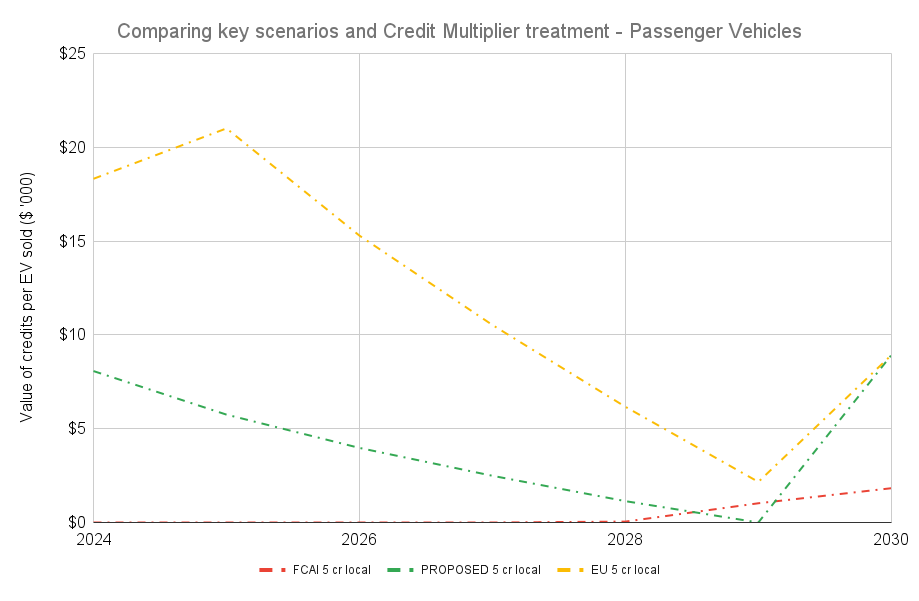
FOI 25-401 - Document 11
benchmark for establishing, documenting and auditing compliance with
certification requirements.
● For the FES to function as designed, there should be no allowable pooling of results
across Passenger and Commercial vehicle segments within or between vehicle suppliers.
● A review of the Australian market clearly identifies that such an allowance would heavily
Arts
unbalance the playing field in the segment with the highest potential for fuel efficiency
gains, the Light Commercial Vehicle market.
the
●
Allowing cross-pooling of results/credits across Passenger and Commercial vehicle
segments within or between vehicle suppliers would be a major failure of policy. A FES
and
policy that allowed this would be one that solely optimises the commercial imperative
of a small handful of powerful legacy vehicle suppliers. This applies similarly to
Infrastructure,
combining Passenger and Commercial vehicles under one target.
of
● The following average economic incentive is modelled to exist to supply additional EVs in
Sport
the passenger vehicle segment that meet the minimum local content threshold (5x
Super Credits) according to various potential FES policy outcomes.
Department
the
by Communications,
1982
Act
FOI Development,
the
under Regional
● The more aggressive early targets of the EU policy can be seen to drive significant costs
into the vehicle supplier market, beyond their capacity to respond with clean vehicle
technology. Roev’s proposal attracts increased overall EV supply at a lower cost to the
consumer, with there being no year in which businesses or consumers are worse-off
economically through either ICE or EV purchase. Such a result is a reasonable baseline
Released Transport,
expectation of consumers and businesses and should be a strong focus of the FES.
CONFIDENTIAL - NOT FOR PUBLIC DISTRIBUTION
FOI page 12 of 26
FOI 25-401 - Document 11
● Off-cycle clean vehicle technology credits should not generally apply. There are
numerous examples of hybrid vehicle technologies applied by certain vehicle suppliers
that enable credits that do not actually deliver these in real-world driving. The AAA real
world fuel efficiency testing process should be considered as a minimum performance
hurdle for these technologies to demonstrate their fuel efficiency driving prowess. If
Arts
AAA testing falls behind the efficiency claims of WLTP testing protocols, no technology
credits should be made available for that vehicle.
the
and
When and how the FES should commence.
Infrastructure,
● More aggressive fuel efficiency targets in the early years of an Australian FES should
coincide with 1-2 years of ‘fair warning’ for those vehicle suppliers that exceed their
of Sport
targets such that a $0g/km clean vehicle incentive applies.
● The recommended commencement date with such a grace period in place is
immediately, or else the market is incentivised to hold back EV volumes as experienced
in other markets in advance of regulatory shift.
● While a $0 clean vehicle incentive (or penalty) would apply to fleetwide fuel efficiency
target breaches in the first 1-2 years, vehicles that meet the local supply content
Department
eligibility thresholds and registered as Electric Vehicles in the Australian market should
receive EV Super Credits that carry over to latter years, to ensure local EV suppliers do
the
not hold-back EV supply to the Australian market.
by Communications,
What level of penalties for non-compliance, and enforcement mechanisms should be
established under an Australian FES to be internationally competitive?
1982
● Supply of clean vehicle technologies is determined largely by the net economic
advantage of supplying vehicles to one location compared to another. Setting a ‘clean
Act
vehicle incentive’ of 95 EURO equivalent - the same as the key competitive vehicle
supply market for Australia - is therefore the lowest responsible target that should be
FOI Development,
applied.
the
Governance and other technical matters to ensure the FES is robust, has low administrative
costs, and establishes appropriate information disclosure rules.
Regional
● The primary means to create and destroy EV credits and Super Credits should be
under
through recorded credit exchange between vehicle suppliers.
● The government should provide the clearing house function, potentially through the
establishment of the Zero Emissions Vehicles National Innovation Council (ZEVNIC),
where all Super Credit exchange arrangements are transparent.
● ZEVNIC would provide services to the Department of Infrastructure in the same way that
Released Transport,
NEVDIS services are provided through Austroads.
CONFIDENTIAL - NOT FOR PUBLIC DISTRIBUTION
FOI page 13 of 26
FOI 25-401 - Document 11
● Remaining clean vehicle incentives payable by vehicle suppliers would be paid into this
clearing house. Such a pool of funds should be required to be used to support EV
charging infrastructure, road safety and local industry development.
Arts
How should the regulated entity be defined in an Australian FES?
● To enable regulated entities to be managed under the optimal policy design presented in
the
this document, regulated entities should be considered as follows:
○ Type Approval holders importing a minimum threshold of vehicles (compulsory)
and
○ SEVS vehicle importers (voluntary opt-in)
○ Vehicle converters (voluntary opt-in)
Infrastructure,
of Sport
Are there any particular FES features that you think we need to take particular care with?
● Creating Super Credits on a sliding scale supporting local content should not be capped
in the number of potential credits available. Vehicle importers should not be eligible for
Super Credits to ensure the proper functioning of the FES.
● The Minister, and not their delegates, should retain an overarching ability to warn
Department
vehicle suppliers and take rare action against vehicle suppliers if they are suspected of
abusing parameters established under the FES. This distinction prevents industry
the
pressure from manifesting off-the-record actions that can distort FES functionality.
by Communications,
Starting emissions level limit and approach • What principles should we consider when
setting the targets?
1982
● To accelerate EV supply and attract local investment in Australian made EVs, the initial
fuel efficiency target should be:
Act
○
Set at 109.3g/km CO2 (4.7L/100km Petrol) for Passenger Vehicles (2024)
○
Set at 153.4g/100km (6.6L/100km Petrol) for Light Commercial Vehicles (2024)
FOI Development,
○
Reduce by at least 4.75% per year until meeting and tracking EU targets.
● More details are provided above on rationale
the
Starting emissions level limit and approach • What should Australia’s CO2 FES target be? •
Regional
How quickly should emissions reduce over what timeframe? • Should the Australian FES start
under
slow with a strong finish, start strong, or be a straight line or take a different approach?
● To maximise overall emissions reduction and local outcomes for jobs and investment, a
more aggressive approach to early targets is recommended.
● This should coincide with 1-2 years of ‘fair warning’ for those vehicle suppliers that
exceed their targets such that a $0g/km clean vehicle incentive applies.
Released Transport,
CONFIDENTIAL - NOT FOR PUBLIC DISTRIBUTION
FOI page 14 of 26
FOI 25-401 - Document 11
● The recommended commencement date with such a grace period in place is
immediately, or else the market is incentivised to hold back EV volumes as experienced
in other markets in advance of regulatory shift.
● While a $0 clean vehicle incentive (or penalty) would apply to fleetwide fuel efficiency
target breaches in the first 1-2 years, vehicle that meet local content minimum
Arts
thresholds and that are registered as EVs in the Australian market for the first time
should receive EV Super Credits that carry over to latter years, to ensure local EV
the
suppliers do not hold-back EV supply to the Australian market.
● The ‘fast finish’ approach to emissions both enables higher overall cumulative emissions
and
from the vehicle fleet, but also optimises for large vehicle supplier margins, rather than
incentivising prioritisation of clean vehicle technologies for the Australian market. The
Infrastructure,
Light Commercial Vehicle segment for example is an ultra-dirty, ultra-high-margin market
of
segment requiring the FES market signal to kick off clean vehicle technology integration.
Sport
Attribute-based emissions limit curve • Should an Australian FES adopt a mass-based or
footprint-based limit curve? • If Australia adopts a mass-based limit curve, should it be based
on mass in running order, kerb mass, or another measure? • Should Australia consider a
variant of the New Zealand approach to address incentives for very light and very heavy
Department
vehicles? If so, noting that new vehicles that weigh under 1,200 kg are rare, where should the
weight thresholds be set?
the
● A foot-print based fuel efficiency standard is not sensible as there is no relationship
by Communications,
between vehicle footprint and fuel efficiency. Such a system would disincentive the
addition of active and passive safety systems which incur weight increases (and fuel
efficiency increases), but which do not affect footprint.
1982
● A mass-based fuel efficiency limit curve is appropriate when the incentive for mass
changes is minimised. Roev considers the EU system efficiency-to-mass limit curve of
Act
straight 0.033 slope is appropriate, based on FCAI reference masses by year.
Development,
Attribute
2024
2025
2026
2027
2028
2029
2030
FOI
Recommended CO2 Target
109.3
103.8
98.6
93.7
88
84.5
61.8
the
Recommended Reference Mass
1578
1584
1589
1594
1599
1604
1609
Recommended efficiency-to-mass
0.033
0.033
0.033
0.033
0.033
0.033
0.033
slope (from EU system)
under Regional
FCAI efficiency-to-mass Slope
0.07
0.068
0.065
0.063
0.061
0.058
0.056
Proportional difference
212%
206%
197%
191%
185%
176%
170%
recommended vs FCAI
efficiency-to-mass slope
● It is noteworthy that the FCAI is proposing a negative effect of mass on vehicle efficiency
Released Transport,
that is generally around twice the effect adopted and successfully operated under by
vehicle suppliers through EU policy.
CONFIDENTIAL - NOT FOR PUBLIC DISTRIBUTION
FOI page 15 of 26
FOI 25-401 - Document 11
Multiple targets • Should an Australian FES adopt two emissions targets for different classes
of vehicles? • Is there a way to manage the risk that adopting two targets erodes the
effectiveness of an Australian FES by creating an incentive to shift vehicle sales to the higher
Arts
emission LCV category? • Is there anything else we should bear in mind as we consider this
design feature? • Are there other policy interventions that might encourage more efficient
the
vehicle choices?
● Australia should adopt two emissions targets for the reasons described above. These
and
targets are Passenger segment ( Passenger, SUV in FCAI/market language) and Light
Commercial segment.
Infrastructure,
● Commercial vehicle and Passenger vehicle segments as defined in the ADRs should
of
have unique targets reflecting the unique demands Australians have on their vehicles.
Sport
● Roev believes there is an ideal start and end point to the ceiling for fuel efficiency over
time. Targets by year proposed below maximise the annual improvement in fuel
efficiency without driving cost of ownership increases - a difficult balance achieved
through development of a market model. The proposed commercial vehicle and
passenger vehicle segment fuel efficiency / emissions target that delivers:
○ Avoidance of overall ownership cost increases;
Department
○ Sufficient incentive and time for OEMs to respond with clean vehicle
technologies; and
the
○ Recognition of the uniqueness of the Australian vehicle market and our
Communications,
dependence on commercial vehicles
by
FES model & segment
2024
2025
2026
2027
2028
2029
2030
FCAI passenger
1982
134
128
122
116
110
104
98
FCAI commercial
177
172
166
160
154
149
143
Act
UN passenger
95
80.75
80.75
80.75
80.75
80.75
61.8
UN commercial
147
125
125
125
125
125
95.6
FOI Development,
Proposed passenger
109.3
103.8
98.6
93.7
89
84.5
61.8
Proposed commercial
153.4
145.8
138.5
131.5
125
125
95.6
the
● The most significant near-term opportunity for improved fuel efficiency and emissions
abatement exists in the LCV segments. To ensure there is focus on bringing clean vehicle
under Regional
technologies to this segment - which is a significant driver of overall profit margins for
many legacy vehicle suppliers - there must be a unique target for the LCV segment.
Critically, EV credits and Super Credits must not be able to be pooled between LCV and
Passenger segments within or between vehicle suppliers.
● Local content Super Credits should be front of mind when considering this aspect of FES
market design. Local jobs and investment outcomes are achievable through FES, while
Released Transport,
such features of FES also lock in long-term local supply through investment attraction
and early price competitiveness.
CONFIDENTIAL - NOT FOR PUBLIC DISTRIBUTION
FOI page 16 of 26
FOI 25-401 - Document 11
● Local-supply friendly FES policy further leverages other government focus on supply
chain establishment in battery technologies, critical minerals and advanced
manufacturing. This design for the FES is the optimal outcome as it incentivises the
dirtiest vehicle supplier to bring clean vehicle technologies to market, or else to support
local investment that does so.
Arts
the
Credit banking, transferring and pooling • To what extent should the Australian FES allow
credit banking, transferring and/or pooling? • Should credits expire? In what timeframe?
and
● The most significant near-term opportunity for improved fuel efficiency and emissions
Infrastructure,
abatement exists in the LCV segments. To ensure there is focus on bringing clean vehicle
technologies to this segment - which is a significant driver of overall profit margins for
of Sport
many legacy vehicle suppliers - there must be a unique target for the segment. Critically,
EV credits and Super Credits must not be able to be pooled between LCV and Passenger
segments within or between vehicle suppliers.
● Tougher earlier targets should be coupled with 1-2 years of ‘fair warning’ for those
vehicle suppliers that exceed their targets such that a $0g/km clean vehicle incentive
applies.
Department
● The recommended commencement date with such a grace period in place is
immediately, or else the market is incentivised to hold back EV volumes as experienced
the
in other markets in advance of regulatory shift.
● While a $0 clean vehicle incentive (or penalty) would apply to fleetwide fuel efficiency
by Communications,
target breaches in the first 1-2 years, vehicle registered as EVs in the Australian market
for the first time should receive EV Super Credits that carry over to latter years, to
ensure vehicle vehicle suppliers do not hold-back EV supply to the Australian market.
1982
This also supports early establishment of local EV industry investments.
● To effectively create a guaranteed value of credits and incentivise the earlier release of
Act
clean vehicle technologies to market, credits carrying forward should not expire or be
devalued. Without a clear business case that can account for credits, it is more difficult
to invest in the production-readiness of clean-vehicle technologies.
FOI Development,
the
under Regional
Released Transport,
CONFIDENTIAL - NOT FOR PUBLIC DISTRIBUTION
FOI page 17 of 26
FOI 25-401 - Document 11
APPENDIX A
Outlining the proposed commercial vehicle and passenger vehicle segment fuel efficiency /
emissions target that delivers:
Arts
● Avoidance of overall ownership costs;
● Sufficient incentive and time for OEMs to respond with clean vehicle technologies; and
the
● Recognition of the uniqueness of the Australian vehicle market and our dependence on
commercial vehicles
and
Vehicle segment
2018 2019 2020 2021 2022 2023 2024 2025 2026 2027 2028 2029 2030
Infrastructure,
CCA proposal ‘14
168
157
146
137
128
120
112
105
of Sport
FCAI passenger
154
150
146
140
134
128
122
116
110
104
98
FCAI commercial
197
193
189
183
177
172
166
160
154
149
143
UN passenger
95
95
95
95
95 80.75 80.75 80.75 80.75 80.75 61.75
UN commercial
147
147
147
147
147
125
125
125
125
125
95.6
Proposed
109.3 103.8
98.6
93.7
89
84.5
61.8
Department
passenger
Proposed
153.4 145.8 138.5 131.5
125
125
95.6
the
commercial
by Communications,
Roev recommends implementation of the reference masses put forward through published FCAI
reports. These accurately reflect the mass of vehicles that consumers in Australia buy, and
reflecting a different reference mass would negatively impact consumer choice.
1982
Despite alignment to the FCAI published reference masses, Roev does not recommend
Act
adoption of the mass-slope presented by the FCAI. The mass-slope the FCAI presents enables
manufacturers to add content to vehicles to increase the vehicle mass to move fuel efficiency
FOI Development,
targets in a way that exceeds the actual negative effect of mass on fuel consumption. This is a
negative incentive and a fuel economy avoidance strategy and Roev recommends the adoption
the
of the EU standard.
Attribute
2024
2025
2026
2027
2028
2029
2030
under Regional
Recommended CO2 Target
109.3
103.8
98.6
93.7
88
84.5
61.8
Recommended Reference Mass
1578
1584
1589
1594
1599
1604
1609
Recommended
0.033
0.033
0.033
0.033
0.033
0.033
0.033
efficiency-to-mass slope
FCAI efficiency-to-mass Slope
0.07
0.068
0.065
0.063
0.061
0.058
0.056
Released Transport,
Proportional difference
212%
206%
197%
191%
185%
176%
170%
recommended vs FCAI
CONFIDENTIAL - NOT FOR PUBLIC DISTRIBUTION
FOI page 18 of 26
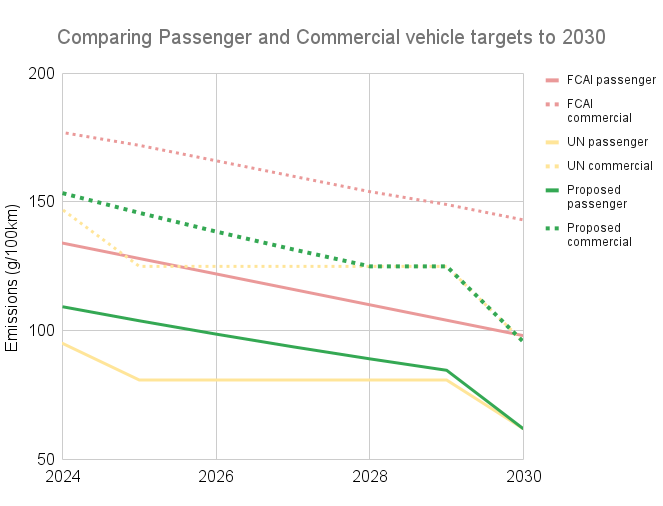
FOI 25-401 - Document 11
efficiency-to-mass slope
It is noteworthy that the FCAI is proposing a negative effect of mass on vehicle efficiency that is
generally around twice the effect adopted and successfully achieved under the EU policy.
Arts
The following chart compares the proposed passenger and commercial vehicle targets to the
FCAI proposed targets and EU market targets. Key points to observe:
the
● Proposed Passenger and LCV targets track smoothly towards EU targets by 2028
and
without setting technically unreachable targets, especially in the near-term years
● FCAI targets are set very high and do not trend towards comparable targets
Infrastructure,
● FCAI targets reflect a ‘no solutions’ approach to the light commercial vehicle segment
of Sport
emissions, with emissions targets set unnecessarily high
Department
the
by Communications,
1982
Act
FOI Development,
the
under Regional
Released Transport,
CONFIDENTIAL - NOT FOR PUBLIC DISTRIBUTION
FOI page 19 of 26
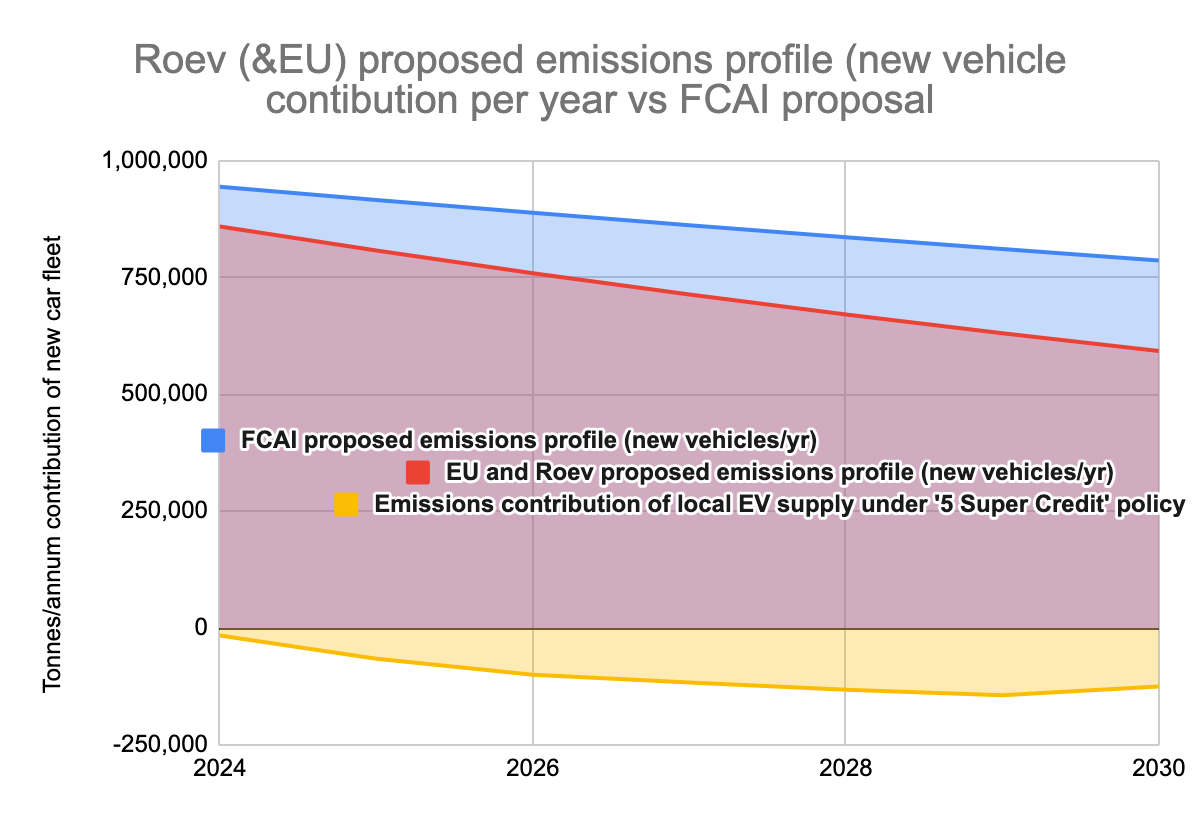
FOI 25-401 - Document 11
Appendix B: Expected results of proposed fuel efficiency standards
Contribution of Super Credit policy vs more strict emissions targets
Roev’s analysis of the relative contribution of emissions reduction in the new car fleet under
FCAI proposed pathway and the maximum potential pathway (EU targets, Roev proposed
Arts
targets) is presented below.
the
Most impactfully, the anticipated additional contribution by Roev alone under the inclusion of ‘5
Super Credits for local supply’ policy in the Fuel Efficiency Standards shows the rate of
and
aggregate emissions reductions can approximately double through this policy inclusion alone.
Infrastructure,
of Sport
Department
the
by Communications,
1982
Act
FOI Development,
the
under Regional
Released Transport,
CONFIDENTIAL - NOT FOR PUBLIC DISTRIBUTION
FOI page 20 of 26
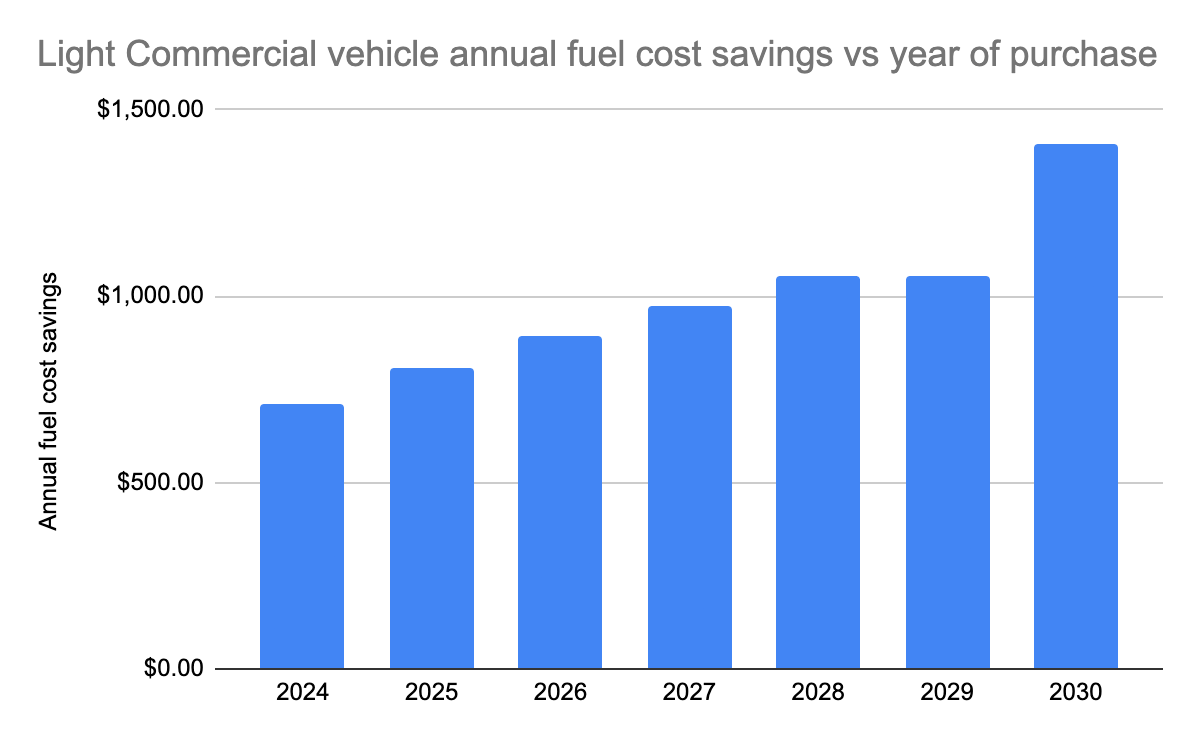
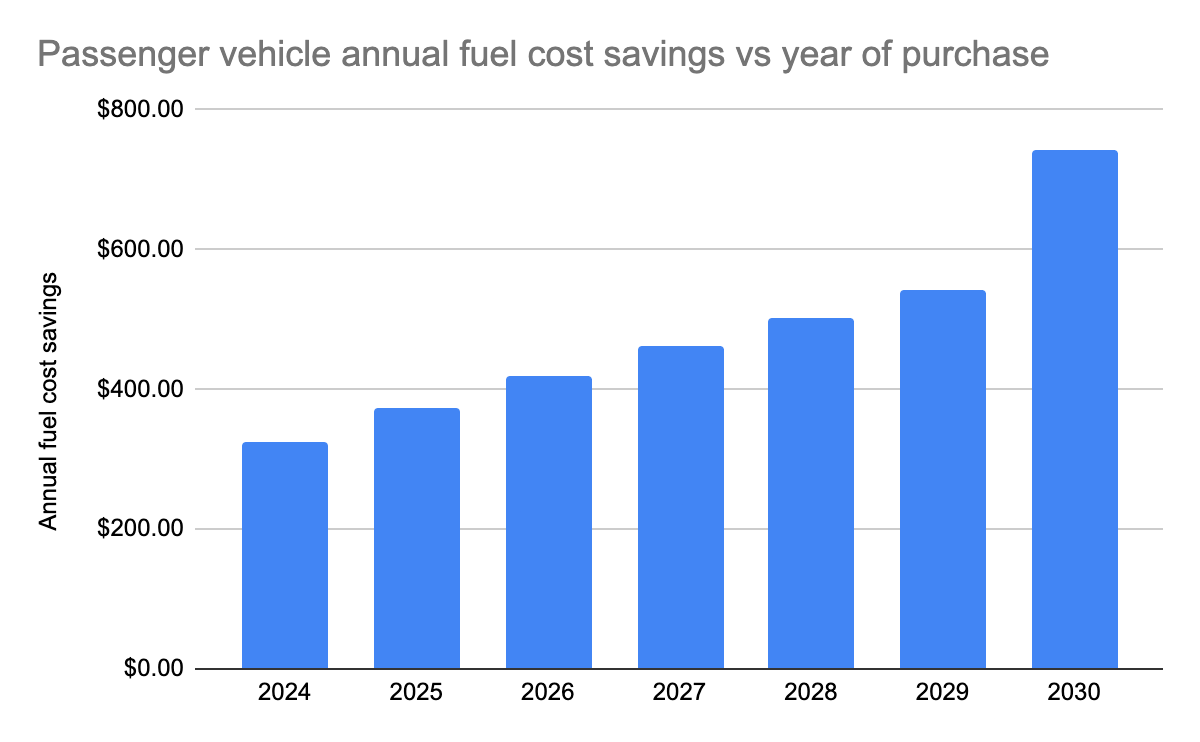
FOI 25-401 - Document 11
Light Commercial and Passenger vehicle annual fuel cost savings vs year of purchase
More strict new vehicle fuel efficiency targets deliver more beneficial fuel cost savings. At 2022
average fuel prices, the all-of-fleet average annual fuel savings for new light commercial and
light passenger vehicles is provided below. Light commercial vehicles travel higher mileage
Arts
(>15,000km) vs 11,100km average for passenger vehicles. As such, LCV fuel cost savings are
higher in all years than for passenger vehicles.
the
and
Infrastructure,
of Sport
Department
Many new vehicles travel even further than the average annual mileage, providing even better
economic return for the clean vehicle technology. Electric vehicles reduce running costs by
the
around 75-80% per km, which can make those vehicles even more cost effective to own than
even the most fuel efficient ICE vehicle.
by Communications,
1982
Act
FOI Development,
the
under Regional
Released Transport,
CONFIDENTIAL - NOT FOR PUBLIC DISTRIBUTION
FOI page 21 of 26
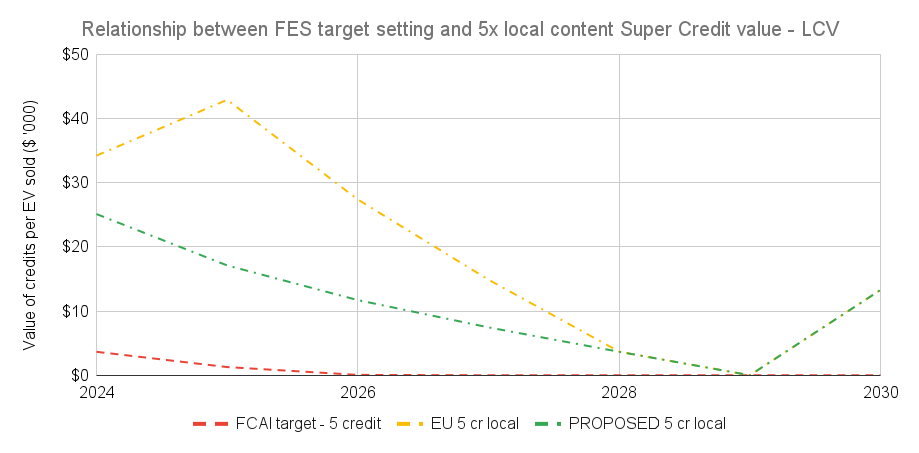
FOI 25-401 - Document 11
Average economic incentive to supply additional electric vehicles meeting the minimum
local content threshold
Vehicle supply is split into 2 key stakeholders; The designer/manufacturer, and the Australian
sales office or representatives. The designer/manufacturer seeks to produce very high volumes
Arts
of products and distribute them to national sales offices across the globe. Profit drives the final
supply location attached to the window of the vehicle as it rolls off the production line.
the
Economic incentives such as the Super Credit scheme work to move the attractiveness of
and
supplying highly limited EVs from one location to another. The following average economic
incentive is estimated to exist to supply additional electric vehicles in the light commercial
Infrastructure,
vehicle market that meet the minimum threshold for local content (5x Super Credits).
of Sport
Department
the
by Communications,
1982
Act
The yellow line which is higher represents the effect of the more aggressive EU targets, vs the
proposed targets represented by the green line.
FOI Development,
Roev’s proposal attracts increased overall EV supply at a lower cost to the consumer, with there
the
being no year in which businesses or consumers are worse-off economically through either ICE
or EV purchase.
It is Roev’s estimation that applying the harsher EU target to this segment in the early years
under Regional
would significantly reduce supply of these highly popular vehicles to market, while exceedingly
low targets provide little incentive to bring clean vehicle technologies to this market.
Released Transport,
CONFIDENTIAL - NOT FOR PUBLIC DISTRIBUTION
FOI page 22 of 26
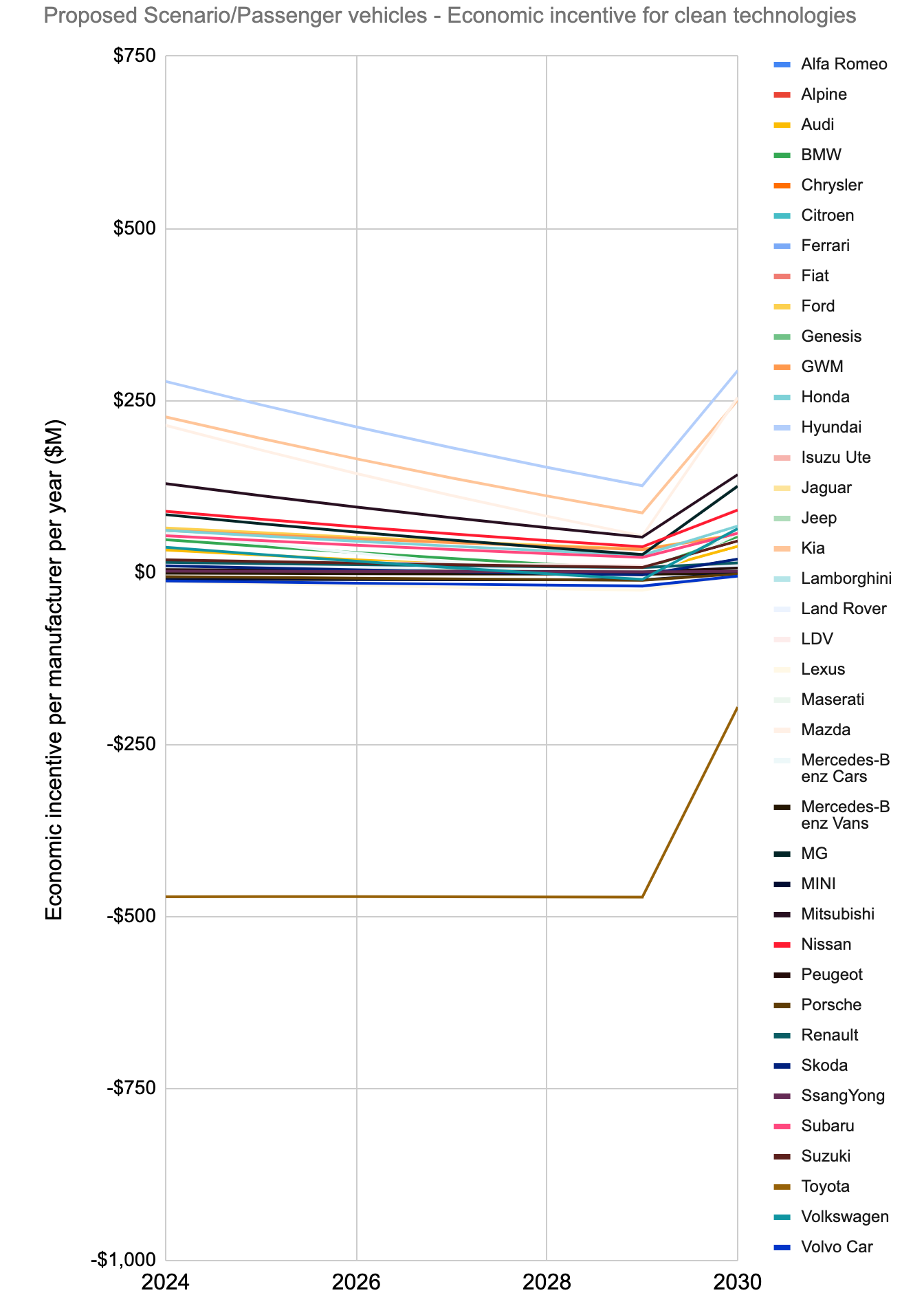
FOI 25-401 - Document 11
Proposed policy outcomes (passenger) - Economic incentive for clean technologies
Arts
the
and
Infrastructure,
of Sport
Department
the
by Communications,
1982
Act
FOI Development,
the
under Regional
Released Transport,
CONFIDENTIAL - NOT FOR PUBLIC DISTRIBUTION
FOI page 23 of 26
FOI 25-401 - Document 11
In the outcomes above for passenger vehicles, Toyota is the standout case with the cleanest
fleet, and hence with the least economic incentive to bring clean vehicle technologies. It is
important to avoid excessive off-cycle credits as Toyota’s outcomes presented above are based
on the off-cycle credit optimised FCAI scheme for computing fleet-wide results. Hyundai, Kia
and Mazda are the three vehicle suppliers with the greatest incentive to clean their fleet
Arts
emissions.
the
and
Infrastructure,
of Sport
Department
the
by Communications,
1982
Act
FOI Development,
the
under Regional
Released Transport,
CONFIDENTIAL - NOT FOR PUBLIC DISTRIBUTION
FOI page 24 of 26
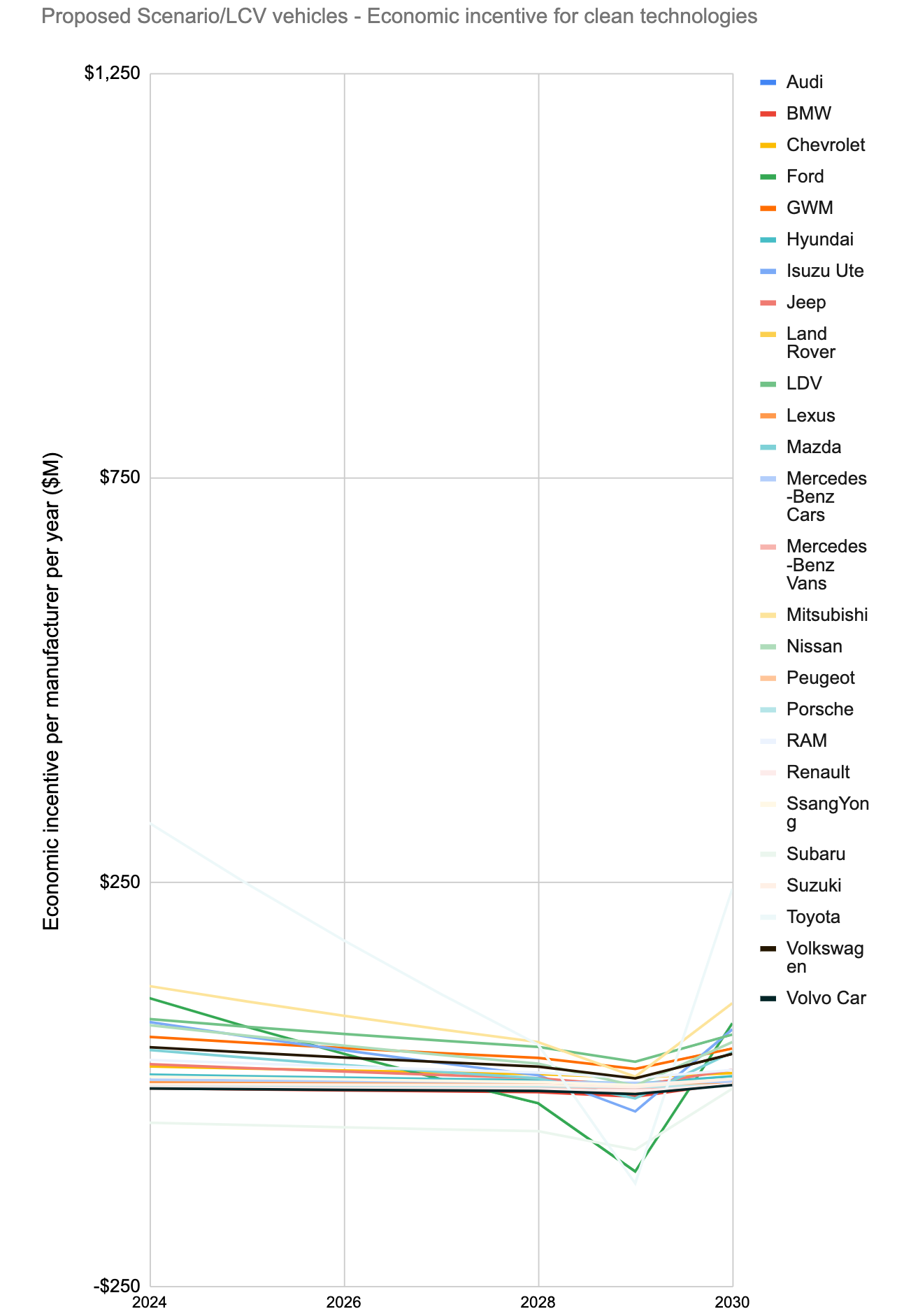
FOI 25-401 - Document 11
Proposed policy outcomes (LCV) - Economic incentive for clean technologies
Arts
the
and
Infrastructure,
of Sport
Department
the
by Communications,
1982
Act
FOI Development,
the
under Regional
Released Transport,
CONFIDENTIAL - NOT FOR PUBLIC DISTRIBUTION
FOI page 25 of 26
FOI 25-401 - Document 11
The most incentivised to develop and bring to market clean vehicle technologies in the light
commercial vehicle space are Toyota, Mitsubishi and Ford. Across both light commercial and
passenger vehicles the largest incentive is to Toyota, Ford, Hyundai, Kia and Mazda.
Arts
the
and
Infrastructure,
of Sport
Department
the
by Communications,
1982
Act
FOI Development,
the
under Regional
Released Transport,
CONFIDENTIAL - NOT FOR PUBLIC DISTRIBUTION
FOI page 26 of 26










